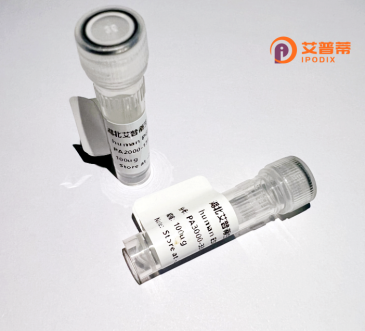
| 纯度 | >90%SDS-PAGE. |
| 种属 | Human |
| 靶点 | WDR33 |
| Uniprot No | Q9C0J8 |
| 内毒素 | < 0.01EU/μg |
| 表达宿主 | E.coli |
| 表达区间 | 1-326 aa |
| 活性数据 | MATEIGSPPRFFHMPRFQHQAPRQLFYKRPDFAQQQAMQQLTFDGKRMRKAVNRKTIDYNPSVIKYLENRIWQRDQRDMRAIQPDAGYYNDLVPPIGMLNNPMNAVTTKFVRTSTNKVKCPVFVVRWTPEGRRLVTGASSGEFTLWNGLTFNFETILQAHDSPVRAMTWSHNDMWMLTADHGGYVKYWQSNMNNVKMFQAHKEAIREARFIHNIPFSVVPIVMVKLFSKCILGAEMHGLCQFLGNFLHPINTIFFFVFTHSPFCWHLSEVVLSRYQPLQYVRDVLSAAFCTGFLFSFMINNVYTLFLFIIYCVRQEYFIPNKEFSL |
| 分子量 | 64.7 kDa |
| 蛋白标签 | GST-tag at N-terminal |
| 缓冲液 | PBS, pH7.4, containing 0.01% SKL, 1mM DTT, 5% Trehalose and Proclin300. |
| 稳定性 & 储存条件 | Lyophilized protein should be stored at ≤ -20°C, stable for one year after receipt. Reconstituted protein solution can be stored at 2-8°C for 2-7 days. Aliquots of reconstituted samples are stable at ≤ -20°C for 3 months. |
| 复溶 | Always centrifuge tubes before opening.Do not mix by vortex or pipetting. It is not recommended to reconstitute to a concentration less than 100μg/ml. Dissolve the lyophilized protein in distilled water. Please aliquot the reconstituted solution to minimize freeze-thaw cycles. |
以下是关于重组人WDR33蛋白的3篇代表性文献摘要概述:
1. **Widespread Polycistronic Transcripts in Fungi Revealed by Single-Molecule mRNA Sequencing**
*作者:Chengqian Zhang et al. (2015)*
摘要:该研究通过mRNA测序发现真菌中广泛存在多顺反子转录本,并揭示WDR33作为CPSF复合体亚基在RNA 3'末端加工中的保守功能。文中通过重组人WDR33蛋白验证其与RNA结合结构域的相互作用。
2. **Structure of the mRNA 3′-end processing complex CPSF–CPF**
*作者:Yadong Sun et al. (2020)*
摘要:利用冷冻电镜解析人源CPSF-CPF复合体的三维结构,发现重组表达的WDR33蛋白通过WD40结构域与其他亚基互作,参与稳定复合体构象,并影响pre-mRNA切割过程。
3. **Molecular Basis for the Recognition of the Human AAUAAA Polyadenylation Signal**
*作者:Shao L. Chan et al. (2014)*
摘要:研究发现重组WDR33与CPSF160共同识别mRNA多聚腺苷酸化信号AAUAAA。通过体外生化实验证明,WDR33的WD40重复区域对RNA结合能力及poly(A)位点选择至关重要。
**Background of Recombinant Human WDR33 Protein**
WDR33 (WD repeat domain 33) is a member of the WD40 repeat protein family, characterized by conserved motifs of ~40 amino acids often terminating with tryptophan-aspartate (WD) residues. These proteins typically act as scaffolding platforms to mediate multiprotein interactions, regulating diverse cellular processes. Human WDR33 contains multiple WD40 repeats that fold into a β-propeller structure, enabling its role in transcriptional and post-transcriptional regulation.
WDR33 is a critical subunit of the cleavage and polyadenylation specificity factor (CPSF), a complex essential for pre-mRNA 3'-end processing. It directly binds to the U-rich elements of pre-mRNAs, collaborating with CPSF160 to recognize polyadenylation signals (PAS) and ensure precise mRNA cleavage and poly(A) tail addition. This process is vital for mRNA stability, nuclear export, and translation.
Beyond mRNA processing, WDR33 may participate in signaling pathways and chromatin remodeling, though its non-canonical roles remain under investigation. Dysregulation of WDR33 has been linked to diseases such as cancer, neurodevelopmental disorders, and autoimmune conditions, highlighting its biological and clinical relevance.
Recombinant WDR33 protein, produced via heterologous expression systems (e.g., *E. coli* or mammalian cells), retains functional domains for structural and interaction studies. It serves as a tool to dissect molecular mechanisms of mRNA processing and explore therapeutic targets for associated pathologies.
×